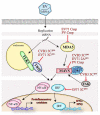Enter at your own risk: how enteroviruses navigate the dangerous world of pattern recognition receptor signaling
- PMID: 23764548
- PMCID: PMC3987772
- DOI: 10.1016/j.cyto.2013.05.007
Enter at your own risk: how enteroviruses navigate the dangerous world of pattern recognition receptor signaling
Abstract
Enteroviruses are the most common human viral pathogens worldwide. This genus of small, non-enveloped, single stranded RNA viruses includes coxsackievirus, rhinovirus, echovirus, and poliovirus species. Infection with these viruses can induce mild symptoms that resemble the common cold, but can also be associated with more severe syndromes such as poliomyelitis, neurological diseases including aseptic meningitis and encephalitis, myocarditis, and the onset of type I diabetes. In humans, polarized epithelial cells lining the respiratory and/or digestive tracts represent the initial sites of infection by enteroviruses. Control of infection in the host is initiated through the engagement of a variety of pattern recognition receptors (PRRs). PRRs act as the sentinels of the innate immune system and serve to alert the host to the presence of a viral invader. This review assembles the available data annotating the role of PRRs in the response to enteroviral infection as well as the myriad ways by which enteroviruses both interrupt and manipulate PRR signaling to enhance their own replication, thereby inducing human disease.
Keywords: Enterovirus; RIG-I-like receptor; Toll-like receptor; Type I IFN.
Copyright © 2013 Elsevier Ltd. All rights reserved.
Figures


Similar articles
-
Innate Immunity Evasion by Enteroviruses: Insights into Virus-Host Interaction.Viruses. 2016 Jan 15;8(1):22. doi: 10.3390/v8010022. Viruses. 2016. PMID: 26784219 Free PMC article. Review.
-
The interaction between human enteroviruses and type I IFN signaling pathway.Crit Rev Microbiol. 2015 Jun;41(2):201-7. doi: 10.3109/1040841X.2013.813903. Epub 2013 Aug 6. Crit Rev Microbiol. 2015. PMID: 23919297 Review.
-
Enteroviruses: A Gut-Wrenching Game of Entry, Detection, and Evasion.Viruses. 2019 May 21;11(5):460. doi: 10.3390/v11050460. Viruses. 2019. PMID: 31117206 Free PMC article. Review.
-
Activation and pathogenic manipulation of the sensors of the innate immune system.Microbes Infect. 2017 Apr-May;19(4-5):229-237. doi: 10.1016/j.micinf.2017.01.003. Epub 2017 Jan 14. Microbes Infect. 2017. PMID: 28093320 Free PMC article. Review.
-
Viral Inhibition of PRR-Mediated Innate Immune Response: Learning from KSHV Evasion Strategies.Mol Cells. 2016 Nov 30;39(11):777-782. doi: 10.14348/molcells.2016.0232. Epub 2016 Nov 18. Mol Cells. 2016. PMID: 27871174 Free PMC article. Review.
Cited by
-
Enterovirus D68 and Human Respiratory Infections.Semin Respir Crit Care Med. 2016 Aug;37(4):578-85. doi: 10.1055/s-0036-1584795. Epub 2016 Aug 3. Semin Respir Crit Care Med. 2016. PMID: 27486738 Free PMC article. Review.
-
Innate Immune Evasion by Human Respiratory RNA Viruses.J Innate Immun. 2020;12(1):4-20. doi: 10.1159/000503030. Epub 2019 Oct 14. J Innate Immun. 2020. PMID: 31610541 Free PMC article. Review.
-
2C Proteins of Enteroviruses Suppress IKKβ Phosphorylation by Recruiting Protein Phosphatase 1.J Virol. 2016 Apr 29;90(10):5141-5151. doi: 10.1128/JVI.03021-15. Print 2016 May 15. J Virol. 2016. PMID: 26962213 Free PMC article.
-
Plum pox virus capsid protein suppresses plant pathogen-associated molecular pattern (PAMP)-triggered immunity.Mol Plant Pathol. 2017 Aug;18(6):878-886. doi: 10.1111/mpp.12447. Epub 2016 Aug 8. Mol Plant Pathol. 2017. PMID: 27301551 Free PMC article.
-
Rhinoviruses and Their Receptors: Implications for Allergic Disease.Curr Allergy Asthma Rep. 2016 Apr;16(4):30. doi: 10.1007/s11882-016-0608-7. Curr Allergy Asthma Rep. 2016. PMID: 26960297 Free PMC article. Review.
References
-
- Centers for Disease Control Non-Polio Enterovirus Infections. 2011
-
- International Committee on Taxonomy of Viruses Virus Taxonomy: 2012 Release (current) 2012
-
- Khetsuriani N, Lamonte-Fowlkes A, Oberst S, Pallansch MA. Enterovirus surveillance--United States, 1970-2005. MMWR Surveill Summ. 2006;55:1–20. - PubMed
-
- Huang C, Morse D, Slater B, Anand M, Tobin E, Smith P, et al. Multiple-year experience in the diagnosis of viral central nervous system infections with a panel of polymerase chain reaction assays for detection of 11 viruses. Clin Infect Dis. 2004;39:630–5. - PubMed
-
- Koskiniemi M, Rantalaiho T, Piiparinen H, von Bonsdorff CH, Farkkila M, Jarvinen A, et al. Infections of the central nervous system of suspected viral origin: a collaborative study from Finland. J Neurovirol. 2001;7:400–8. - PubMed
Publication types
MeSH terms
Substances
Grants and funding
LinkOut - more resources
Full Text Sources
Other Literature Sources

